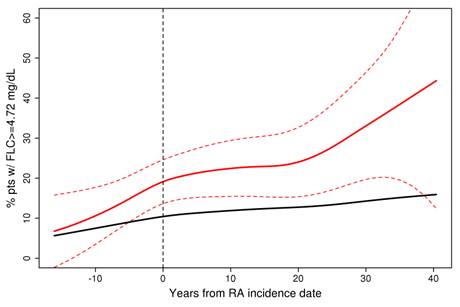Session Information
Title: Rheumatoid Arthritis - Clinical Aspects II: Identifying Rheumatoid Arthritis in At-Risk Populations
Session Type: Abstract Submissions (ACR)
Background/Purpose: Serum immunoglobulin free light chains (FLCs) represent biomarkers of B-cell activation and have been associated with rheumatoid arthritis (RA) as well as all-cause mortality in the general population. The objective of this study was to evaluate the relationships of serum FLCs to pre-clinical disease, RA characteristics, and mortality in persons with RA compared to non-RA subjects.
Methods: A population-based study during the period of 1995 – 2003 was performed by cross-linking a large cohort in the general population with available serum FLC data with our established RA inception and prevalence cohorts. FLCs were measured using commercial immunonephelometric assays. The estimated glomerular filtration rate (eGFR) was estimated using the CKD-EPI formula. Levels of serum κ, λ, and total FLCs and their trends relative to RA incidence were compared between RA and non-RA subjects. Associations between RA disease characteristics and serum total FLCs were assessed using linear and logistic regression models, adjusting for age and sex. Among the population with normal κ-to-λ ratio (0.26 – 1.65), Cox models were used to determine the association between serum FLCs and mortality, adjusting for age, sex, serum creatinine, and the RA × FLC interaction variable.
Results: Among 16,609 subjects, 270 fulfilled criteria for RA at the time of the serum FLC measurement. The patients with RA were slightly older (mean age 67 vs. 65 years, p<0.001) and more frequently female (68% vs. 55%, p<0.001). The mean κ-to-λ ratio was similarly normal in both groups (p = 0.9), and there was no difference in the proportions of RA and non-RA subjects with an abnormal κ-to-λ ratio, which by definition indicates monoclonal gammopathy (3.3% vs. 4.1%, p=0.48). Significant elevations of κ, λ and total FLCs were observed in the RA compared to non-RA subjects (mean total FLCs: 4.2 vs. 3.3 mg/dL, p<0.001). These findings were not explained by any difference in the mean eGFR, which was similar between the groups (64.8 vs. 65.2 mL/min/1.73 m2, p=0.56). Serum FLCs became elevated 3 – 5 years before the clinical onset of RA and remained elevated during follow-up (Figure). Total FLCs were associated with severe extra-articular manifestations (odds ratio = 3.64; 95% confidence interval [CI]: 1.26, 10.58) but not with rheumatoid factor or the sedimentation rate. Finally, total FLCs were associated with increased mortality in the RA population (hazard ratio = 1.07 per mg/dL; 95% CI: 1.03, 1.11), though the effect on mortality appeared to be attenuated in RA compared to non-RA subjects, perhaps due to treatment with immunosuppressive therapies or to other competing factors.
Conclusion: Serum FLCs are significantly elevated in patients with RA compared to the general population. The elevation of serum FLCs precedes the clinical onset of disease. Serum FLCs may be useful in monitoring B-cell activity and in assessing prognosis.
Disclosure:
J. M. Davis III,
None;
S. V. Rajkumar,
None;
C. S. Crowson,
None;
X. Deng,
None;
A. Dispenzieri,
None;
D. R. Larson,
None;
T. M. Therneau,
None;
E. L. Matteson,
None;
R. A. Kyle,
None;
J. Katzmann,
None;
S. E. Gabriel,
None.
« Back to 2013 ACR/ARHP Annual Meeting
ACR Meeting Abstracts - https://acrabstracts.org/abstract/serum-immunoglobulin-free-light-chains-and-rheumatoid-arthritis-a-population-based-study/

